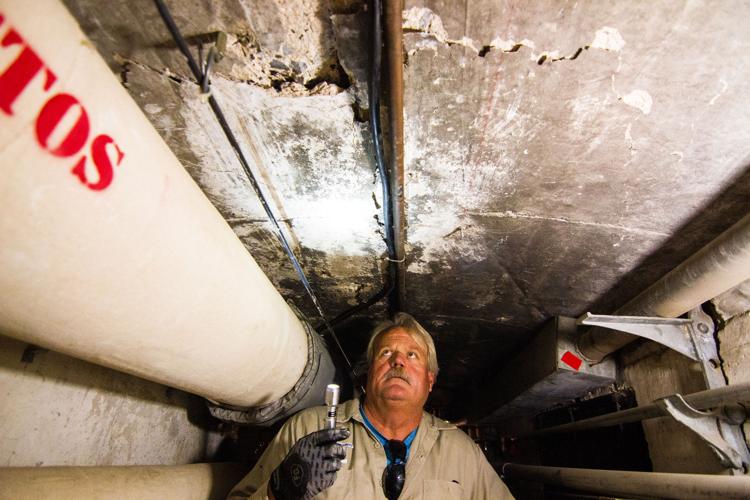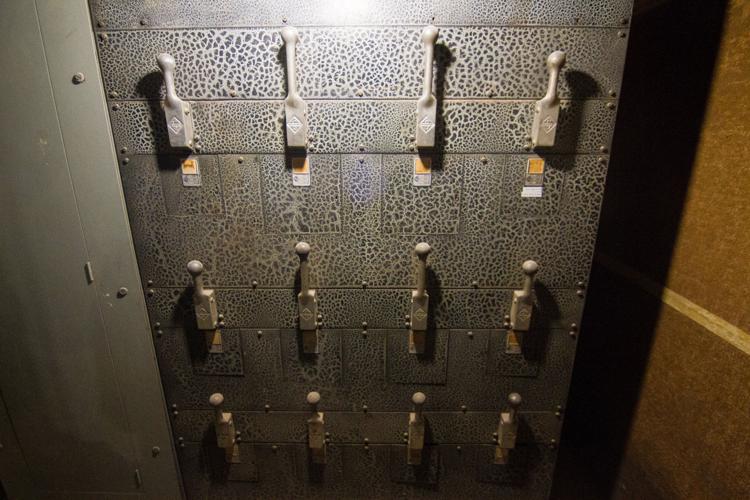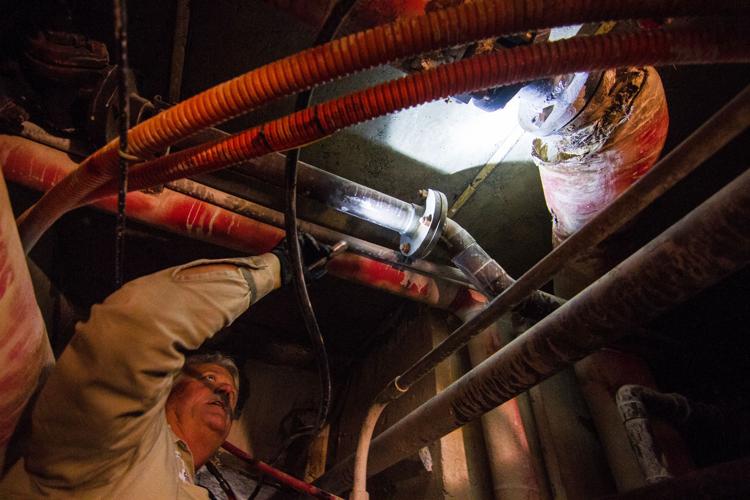University of Arizona facilities need about $350 million in deferred maintenance, and without significant investment that cost could balloon to more than $1 billion in the next decade, school officials said.
A plan in Gov. Doug Ducey’s proposed state budget could result in the university being able to use some sales-tax revenue to put a dent in the long list of needed capital improvements.
The university’s chief financial officer, in a presentation to the Arizona Board of Regents, called the disrepair a “ticking time bomb,” saying it’s just a matter of time until the lack of timely repairs and maintenance creates an emergency situation.
It already has caused some significant problems.
The UA had to repair collapsed concrete on a road near the Student Union while students and faculty were on winter break. In another instance, an electrical fire and loss of power last July at Banner-University Medical Center forced the hospital to evacuate some patients for 24 hours while repairs were made.
UA officials analyzed all facilities and identified seven buildings on the main campus as being outdated and in need of the most repairs. They are: Forbes, Steward Observatory, Biological Sciences East and West, Harshbarger, Shantz and the College of Medicine.
Another building, Old Chemistry, built in 1936, which overlooks the UA Mall from the south, is on the list for demolition. Everything, save for its historic facade, has to go, but there aren’t any immediate plans to replace the building.
An anthropology professor called his classroom inside Old Chem “depressing,” saying he hears strange noises every now and then. “It’s not a great educational environment,” said Matthew Rowe, the professor. But he didn’t know it was so bad it had to be demolished.
The buildings and their infrastructures have lived, and are living, long past their life spans, said Chris Kopach, assistant vice president of facilities management. Most of them were built before the 1970s. For instance, the Forbes building, where the agriculture department is based, was built in 1915, though it has had upgrades over the years.
Some of the signs of disrepair include cracked concrete, deteriorated insulation, duct leakage, antiquated cold rooms and inefficient lab exhausts. The electrical, mechanical and air-handler systems are 50 to 60 years old in the seven buildings, when the recommended life span would be about 25 years, he said.
It’s not that those buildings are not safe to be in, Kopach said. “As far as the buildings being safe, they’re all safe. This is no different than when you have a home and you have aging infrastructure and equipment.”
The disrepair that poses immediate risk of fire or to safety are addressed quickly, he said. Most of the deferred maintenance is what goes on underneath the layers the public can see, with more than half of it having to do with old heating and cooling systems.
However, there are health issues associated with the systems’ disrepair in buildings.
A UA presentation, as part of its strategic plan, includes a brief on indoor health issues related to deferred maintenance, which says that “long-term effects of temperature, humidity, pressure, noise, vibration, particulates and airborne contaminants may have direct and indirect consequences on individual health.”
Parts of the governor’s proposed budget may allow for additional capital funding for the state’s three public universities to deal with matters such as deferred maintenance and also to invest in newer buildings for research.
But until the budget makes its way through the Legislature, it’s business as usual for the UA: focusing on emergency repairs and preventive measures.
Underground system
Beneath the campus lies a utility tunnel system of more than 6½ miles that supplies water, steam and more to buildings . The steam that’s used to heat the classrooms during cold weather? That comes through those underground pipes.
Rick Lower, a facilities superintendent, is one of three employees tasked with traveling through the vast tunnel system daily to make sure everything is working, though a lot of monitoring is done remotely through electronic systems.
Late last year, Lower discovered the concrete on James E. Rogers Way, a narrow one-way road just south of Second Street that connects east and west sides of the campus, had collapsed on top of the tunnel.
Water had infiltrated the concrete over the years, rusting and stretching the rebar that separated the concrete, Lower said. There’s also heavy pedestrian and vehicle traffic in the area.
While students and faculty were away on Christmas break, the facilities management team removed the collapsed concrete, formed a new lid, installed rebar, waterproofed the structure and refilled the concrete in 2½ weeks. That ended up being a costly repair — about $300,000.
There are other parts of the tunnel that need maintenance. There’s concrete falling from heavy traffic in several corridors. “We handle it on an emergency basis,” Kopach said. When there’s more than $300 million worth of maintenance needing to be done, that’s often how it works.
A UA-developed technique is actually helping the university address some of the tunnel issues. Mo Ehsani, a structural engineering professor in the civil engineering department, developed the “Quake Wrap” method, which uses fiber-reinforced polymer to strengthen the structures.
As far as outdated equipment, the facilities management team has done a remarkable job of keeping systems more than 50 years old running, Kopach said. Some of the electrical equipment housed underneath the Arizona State Museum might as well be in the museum because it’s so old, he said.
In the electrical outage at Banner-UMC last July, the problem was caused by an old electrical system owned by the UA. In fact, it was so old that parts for it had to be bought on eBay, as 1960s high-voltage fuses it needed were no longer being commercially manufactured.
Hopes raised
Gregg Goldman, the UA’s CFO and senior vice president of business affairs, said he was excited to hear the governor’s budget included a sales-tax recapture plan to make capital funding available to the universities.
“I think this is an amazing step in the right direction to solve two problems,” he said. “One, research infrastructure and new buildings are critical to fund, to be able to attract and retain our top faculty, which helps our contracts and grants and helps us find the next new big thing. It also helps us recognize the older buildings.”
Essentially, what it does is allow universities to take back the sales tax they pay, which would then be matched by each of the three universities and gives them bonding authority. For the UA, the sales-tax recapture program could lead to more than $400 million in bonding capacity.
While no decisions have been made about what to prioritize, if the sales-tax plan is approved, Goldman said about $225 million could go toward the $350 million deferred-maintenance problem.
“Renewal is cumulative,” he said. “If we can change the dialogue and change the equation, where now we’re taking $225 million and putting it toward this problem, it’s not going to compound up to a billion.”
Goldman said the university must focus on both building new infrastructure and fixing old infrastructure. Part of that is recognizing the historical significance of some of the buildings, but also recognizing the need to grow the university enterprise.
If the sales-tax plan is not approved as part of the state budget, the need to solve the deferred-maintenance issue doesn’t diminish, he said. “It just means we need to find other ways to connect the dots to make it happen.”







